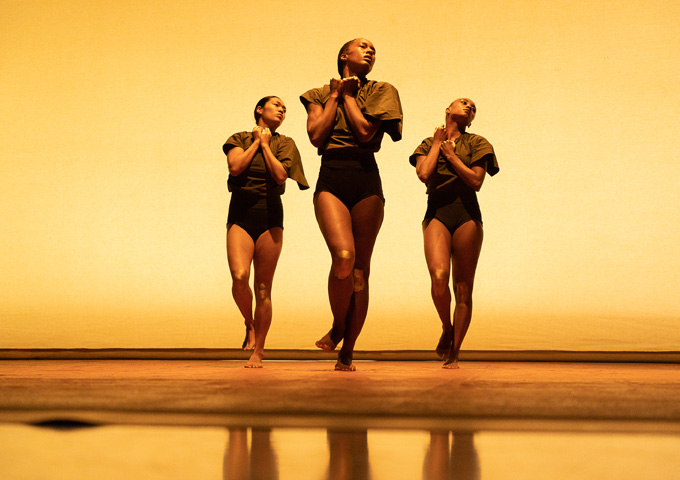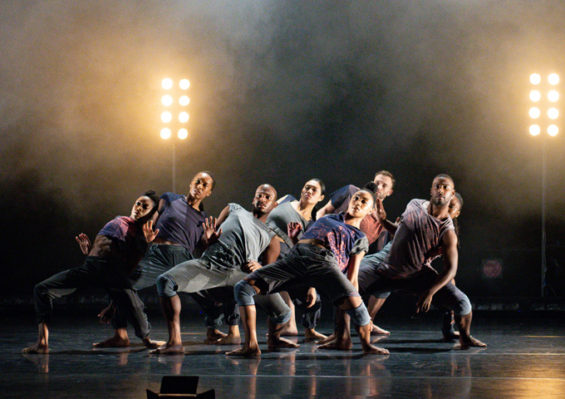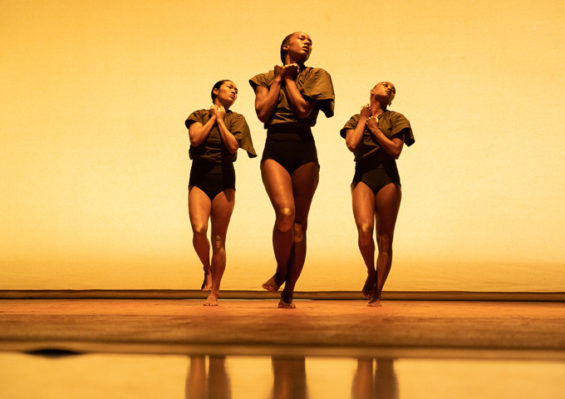Dance Review: A.I.M by Kyle Abraham


Photo by Grace Kathryn Landefeld, courtesy of Jacob’s Pillow.
Kyle Abraham is looking for something. The multi-award-winning choreographer and MacArthur “Genius” Fellow, whose company, A.I.M by Kyle Abraham, makes its mainstage debut at Jacob’s Pillow this week, brings his signature search for identity and struggle with personal and societal emotional trauma to a packed, five-dance program.
The performance begins with state, an ambient piece for three female dancers choreographed by Andrea Miller. The stark images their bodies make when silhouetted against a light background, or when projected as supersize shadows, are visually arresting. And in the middle section, as the movements go from small and controlled to larger and more expansive, and sometimes tortured, is especially strong. But Miller’s abstraction is sometimes a distraction, and as the dance ends, the audience is left wondering if all those exertions added up to anything.
INDY, a solo choreographed and danced by Abraham himself, is more affecting. Using his signature contemporary-grounded, hip-hop-inspired style, he transforms into a person trying on different skins—catwalk queen, a swaggering young man, a shy flirt, a man breaking his own bonds. As the dance progresses, he rapidly cycles through these personas, practically turning himself inside out in the process. From here he strips down—literally removing his fringed shirt and pants. Parts of this middle section, where Abraham deconstructs traditional dance movement—développés that never quite develop, turns lopped off before completion—are absorbing. But the impact gets lost in extended passages with little to no movement, and it begins to border on performance art.

Photo by Grace Kathryn Landefeld, courtesy of Jacob’s Pillow.
The Quiet Dance, Show Pony, and Drive, while still abstract, rely on a more familiar contemporary vocabulary and fluidity of movement. In the former, a group of five dancers, four dancing mostly in unison and one solo, seem to grapple with an inability to speak, whether from the outside or self-imposed, that leaves them frustrated and weary. It bears several hallmarks of Abraham’s choreography—the deep lunges, weight shifting from foot to foot, arms rocking from side to side in a low port de bras—but its more subtle approach provides a welcome counterpoint to the earlier dances.
Show Pony, a solo for the outstanding Marcella Lewis, is its opposite—bold, sharp, and high-energy—as she transitions from one movement phrase to the next at the blow of a whistle. Drive is a fitting title for the closing dance. Fluid and muscular, it’s the only dance on the program to fill the stage with leaps, jumps, and turns. Drive is the biggest spectacle on the program, thanks in part to its throbbing beat and flashing lights, but it’s hard not to think that the dance would be better served with a more interesting piece of music.
Whether Abraham finds what he’s seeking in this program is an open question. While he and his dancers all possess extraordinary quality of movement and their raw emotion is often stirring, the choreography sometimes feels like sound and fury, signifying ideas not entirely formed.